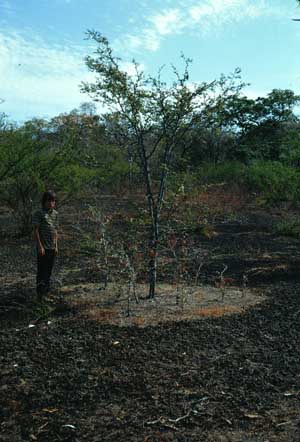|
|
 64 serendipitous consequence DHJanzen100146.jpg high resolution
|
|
| The there is one non-evolved serendipituous consequence for the ants and the acacias of clearing the basal circle. When ant acacias grow in pastures (a recently invented habitat type, at best 400 years old in the neotropics), the basal circle free of vegetation becomes effectively a small personal fire break, especially if the pasture is closely grazed and therefore does not carry a very deep fire (burning the tall grass). This means that a grass fire can pass through without killing either the above-ground acacia and/or acacia-ant colony. In this image the unbured area below the ant-acacia, and the green surviving leaves in the crown, are very visible after the fire has passed through. However, it is important to note that this was not the selective pressure that evolved the aggression of acacia-ants to plants, since that is a trait of acacia-ants throughout their distributions and fire has not been a part of the evolutionary regime of these plants up until a few hundred years ago (and then, only in a few select habitats). | ||
back to lecture slides
or skip to: